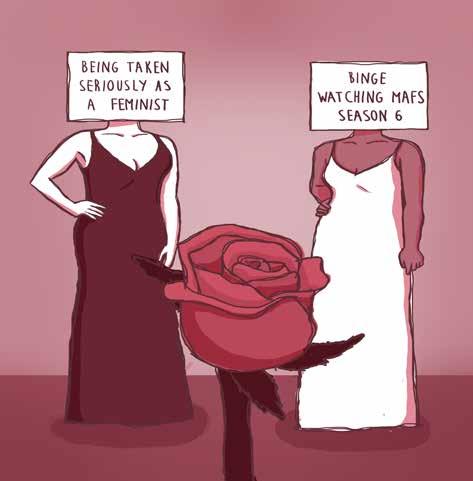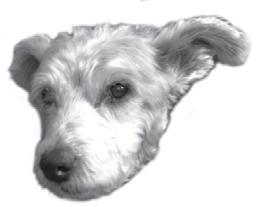
8 minute read
Multi-lingual


Advertisement
Need Help? Ask the SRC.
Our caseworkers provide FREE, independent, confidential advice and advocacy for Sydney University undergraduates
Academic Rights & Appeals • Special Consideration • Plagiarism / Misconduct Allegations • Centrelink, Debt & Finance advice • HECS Refunds • Tenancy & Accomodation advice • Harrassment & Discrimination support and more...



Victor Zhou wants to talk about the sculpture we all love to hate. Last week, I stood in front of the sandstone monolith sculpture that has sat on Eastern Avenue since 2018, asking passers-by for their thoughts on it. Jayde was “not mad” it was there, Nathaniel said it was “beautiful” and Franco said it was “vaguely phallic.” But for Tatenda, Erika and Connor the answer was simply “I don’t know.”
For many students, including myself, the sculpture was a confusing site to behold when it first appeared on campus in December 2018. Indeed, for weeks, the accompanying Eastern Avenue installation, a piece inspired by ochre art on the exterior wall of the Carslaw Building, was mistaken by many for incomplete wall remodelling.
Though the University claims that the response from the student community has been “overwhelmingly positive” in a popular USyd Rants post on the work, students’ responses were largely negative. “This ‘sculpture’ is a complete waste of time and money as usual” one comment complains. “I thought they were missing a piece of sandstone and didn’t know what to do with it, and just dumped it there...” another reads.
After hearing their first impressions, I told the onlookers that the work, Spine 2 (2018) was by Dale Harding, a Bidjara, Garingal and Ghungalu artist. In an article published by the University of Sydney, Harding says the work “seeks to make connections between the University campus and the sandstone that joins cultures and communities up and down the east of the continent.”
Most interviewees critiqued the work as not particularly appealing, but that upon learning about the work, acknowledged that the intended meaning was important.
Hearing this, it seems to fail what some argue to be the core criteria of successful public art, namely, as art historian Cher Krause Knight argues, that its “messages are comprehensible to generalised audiences.” Outside of the realm of the gallery and stripped of explanation and context, most audiences are left unequipped to understand the meaning of the artwork. On this view, the University’s decision to initially display the work with minimal explanation and consultation with the university community is questionable. The piece was displayed for a year before placards explaining the works were included were displayed alongside them.
Importantly, as I research Harding’s works for this piece, the more I find them compelling. The juxtaposition of this sandstone with the surrounding buildings, symbols of elite Australian education, makes the familiar space of the university strange and different. It helps us interrogate what kind of space a university, particularly one built on colonised land.
Moreover, the piece intervenes in the built environment of Eastern Avenue. Not all notice it, but the native plants surround the work are an element of it. The native plants are still young, some of them barely reach my kneecaps. We can speculate, however, that in the future the plants will grow higher. I can imagine them covering a good portion of the sculpture—or maybe even overgrowing and overwhelming the sculpture and becoming the sculpture itself.
“A key part of Dale’s work is its integration with the landscape,” says a recent article published by the University. “The native planting component is a collaboration between Dale and the University’s Grounds team.”
The artwork, therefore, is in a continual process of growing, struggling, and becoming. It is not a “museum artefact” like those living cultural objects which were plundered from Indigenous worlds and then preserved and frozen behind pristine imperial walls where they are reduced to objects of study and display. Those living cultural objects became frozen and dead when they were preserved in imperial institutions and deprived from practices of care and use by their original owners. Spine 2, however, is not preserved, it is a living object affected by the weather and time, but during its life it can be cared for by the artist’s own terms. For me, its potentiality to be cared for and to grow beyond what it is now makes it poetic and beautiful. For many students, Spine 2 is just another sandstone block. At best, unremarkable, and at worst an unsightly and confusing intrusion on their campus. But for students curious enough to prod further, Harding’s work will make them see their campus in a new light, drawing connections between this learning institution and the culture of the Indigenous lands it’s built on. In either case, it’s a ground for debate, discussion and exploration. Love it or hate it, Harding’s art provokes the viewer. And for that, I think, it must be applauded.
Strings of Conciousness: A Conversation with QUART-ED
Angelina Nguyen chats with QUART-ED, a string quartet with big ideas for music education. Meet QUART-ED, an electrifying string quartet featuring violinists Sarah and Caitlin, violist Connor and cellist Karen. Trained at the Sydney Conservatorium of Music, they use interactive performances to entertain and enlighten their audiences whether they are primary school children to seasoned concert-goers. QUART-ED believes in making music accessible and enjoyable for all, embracing a diverse repertoire of music that ranges from Vivaldi’s Summer to Moana’s How Far I’ll Go. In this interview, QUART-ED share some of their eclectic experiences as emerging performers, professional educators and lifelong students themselves. How did you all meet and what made you decide to form QUART-ED? Karen: It started at the Con when we were having instrumental lessons and classroom training. At some point, we just wondered “why don’t we do those things at the same time?” and that’s how we got together coming out of our first primary school placement. We also wanted to broaden views on string performance. We are trained in a pluralist style, which is a framework that looks at blending and embracing a variety of approaches and experiences. We thought it would be worth applying to our instruments’ repertoires and expanding the ideas on the music they can play. Sarah: Another part that plays in our story is that we are education students. Playing a Beethoven string quartet was not going to be our forte. With pluralism, we know how important it is to branch out, not box ourselves in and see what other music there is out there to play. What opportunities have you been involved in over the last year or so and what were your highlights? Karen: One of our biggest hurdles was performing as part of VIVID’s Konzertprojekt series. We were asked to perform eighty minutes of repertoire which was not something we were used to doing but it was perhaps what made it the most memorable experience to me. The program consisted of Australian musical works because we wanted to showcase local, contemporary talent and workshopped closely with the composers we chose. Sarah: It was a huge experience juggling university with this concert program and the responsibilities that came with it behind the scenes with tech. At the end of the day, it was intense but incredibly rewarding. Connor: We also did a gig for the Con at the end of last year at the International Towers which was fun. I found it interesting because it wasn’t directed to our usual audience. They were caught a little by surprise because of how interactive our performance was, especially compared to the other musicians they had seen around. Karen: It was really fun just watching adults play with the activities we usually give ten-year-olds and unlocking that since they presumably don’t utilise much in a regular working day. How does the kind of music QUART-ED perform align with your philosophy as educators? Connor: Our overarching philosophy is very much driven by the belief that we should make performing interesting, engaging and activity-based as you would do in the classroom. Caitlin: We really like to push ourselves as musicians and educators. When Karen introduced us to the idea of singing and playing simultaneously, and integrating Connor’s beatboxing skills, it made sense to put these into practice with this with our program. Our performances definitely mirrors pluralism, with all of us exploring different ways of music-making, incorporating a variety of styles, and with me also composing a piece Something About the Ocean where we get the audience joining us in the performance too. How has what QUART-ED has done been influenced by your studies at the Sydney Conservatorium of Music? Sarah: I do think how we learnt in the degree which is all about experimental learning and hands-on involvement within the classroom influenced a great part of how we do things with QUART-ED.
Caitlin: We definitely have the Music Ed staff to thank for introducing us to the idea of pluralism officially. I think my development of a musician holistically influenced my support for pluralism and constructivism that were introduced to me in the degree.
Connor: I could almost argue that we would’ve still done this if we had gone to any other institution. I think I’d like to credit myself and the others for just wanting to do something different and fun to learn more; that being said, the Con was and still is extremely open to validating, rewarding and giving us a space to do it.
What are QUART-ED’s plans for 2020?
Karen: I’m finishing my last year in Music Ed and QUART-ED will be involved in my Honours study. I’m researching what we as an ensemble can offer to teachers and how music education’s impact can continue past our visits to the schools. We are also hoping to perform more frequent public concerts.
Sarah: Another regional schools tour is hopefully happening. We’ve had good feedback and it’s something that really benefits the schools that we visit so fingers crossed for another eventful year.










